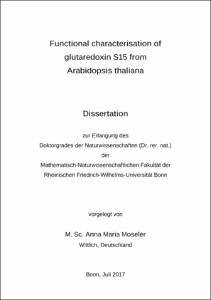Moseler, Anna Maria: Functional characterisation of glutaredoxin S15 from Arabidopsis thaliana. - Bonn, 2017. - Dissertation, Rheinische Friedrich-Wilhelms-Universität Bonn.
Online-Ausgabe in bonndoc: https://nbn-resolving.org/urn:nbn:de:hbz:5n-49241
Online-Ausgabe in bonndoc: https://nbn-resolving.org/urn:nbn:de:hbz:5n-49241
@phdthesis{handle:20.500.11811/7314,
urn: https://nbn-resolving.org/urn:nbn:de:hbz:5n-49241,
author = {{Anna Maria Moseler}},
title = {Functional characterisation of glutaredoxin S15 from Arabidopsis thaliana},
school = {Rheinische Friedrich-Wilhelms-Universität Bonn},
year = 2017,
month = dec,
note = {Iron-sulfur clusters (ISCs) are essential cofactors that are composed of iron and inorganic sulfur. A complex assembly pathway conveys their initial synthesis and subsequent binding to the respective apoproteins. With the exception of plastids, that are equipped to synthesise ISCs for their own set of FeS-proteins, all other cellular FeS-proteins depend on the mitochondrial ISC machinery and the ATP-binding cassette transporter ATM3 in the inner membrane of mitochondria that transports a yet unidentified sulfur-component from the mitochondrial matrix into the cytosol. FeS-protein maturation can be divided into three steps: the assembly of the ISC on a scaffold protein, the transfer of the nascent ISC via carrier proteins and the insertion of the ISC into specific apoproteins.
This work focusses on the role of the monothiol glutaredoxin S15 (GRXS15) as a carrier protein as well as the impact of the glutathione pool on maturation of mitochondrial and cytosolic FeS-proteins. Here, the identification of previously unrecognised embryonic lethal Arabidopsis mutants deficient in mitochondrial GRXS15 is shown. Recombinant GRXS15 coordinates an ISC in the presence of reduced glutathione as a cofactor. Genetic interference with ISC coordination through targeted mutagenesis diminished the ability of the protein to complement a yeast mutant lacking the homologous mitochondrial Grx5p. Similarly, the mutated GRXS15 variant K83/A was not able to fully complement the lethal Arabidopsis mutants. Partial complementation results in a dwarf phenotype and severely diminished aconitase activity. Furthermore, the complemented mutants displayed disturbances in metabolic pathways that are connected with lipoylated proteins. Taken together, genetic evidence and metabolic characterisation uncovered the role of mitochondrial GRXS15 in FeS-protein maturation, particularly that of aconitase and lipoic acid synthase. Lack of “classical” oxidoreductase activity in vitro additionally supports the function of GRXS15 as an ISC carrier protein. Unexpectedly, the K83/A variant showed an enhanced GSSG-dependent oxidation of redox-sensitive GFP (roGFP2). This increased catalytic activity, however, is not based on an improved interaction with roGFP2 but rather points to an essential role of the amino acid substitution on GRX function itself.
Furthermore, it is shown that neither a reduced glutathione amount nor an increase in mitochondrial matrix GSSG influences the maturation of mitochondrial as well as cytosolic FeS-proteins. GSH-depletion does not affect the downstream targets of GRXS15. Still, ISC coordination of GRXS15 is stabilised by GSH addition in vitro, while the GRXS15 holoprotein is just slightly destabilised by GSSG. The negligible impact of GSSG on GRXS15 function was also confirmed in vivo using an atm3-4gr2epc2 double mutant. Although high mitochondrial GSSG aggravates the atm3 phenotype the atm3-4gr2epc2 shows no decreased activity of cytosolic FeS-proteins.},
url = {https://hdl.handle.net/20.500.11811/7314}
}
urn: https://nbn-resolving.org/urn:nbn:de:hbz:5n-49241,
author = {{Anna Maria Moseler}},
title = {Functional characterisation of glutaredoxin S15 from Arabidopsis thaliana},
school = {Rheinische Friedrich-Wilhelms-Universität Bonn},
year = 2017,
month = dec,
note = {Iron-sulfur clusters (ISCs) are essential cofactors that are composed of iron and inorganic sulfur. A complex assembly pathway conveys their initial synthesis and subsequent binding to the respective apoproteins. With the exception of plastids, that are equipped to synthesise ISCs for their own set of FeS-proteins, all other cellular FeS-proteins depend on the mitochondrial ISC machinery and the ATP-binding cassette transporter ATM3 in the inner membrane of mitochondria that transports a yet unidentified sulfur-component from the mitochondrial matrix into the cytosol. FeS-protein maturation can be divided into three steps: the assembly of the ISC on a scaffold protein, the transfer of the nascent ISC via carrier proteins and the insertion of the ISC into specific apoproteins.
This work focusses on the role of the monothiol glutaredoxin S15 (GRXS15) as a carrier protein as well as the impact of the glutathione pool on maturation of mitochondrial and cytosolic FeS-proteins. Here, the identification of previously unrecognised embryonic lethal Arabidopsis mutants deficient in mitochondrial GRXS15 is shown. Recombinant GRXS15 coordinates an ISC in the presence of reduced glutathione as a cofactor. Genetic interference with ISC coordination through targeted mutagenesis diminished the ability of the protein to complement a yeast mutant lacking the homologous mitochondrial Grx5p. Similarly, the mutated GRXS15 variant K83/A was not able to fully complement the lethal Arabidopsis mutants. Partial complementation results in a dwarf phenotype and severely diminished aconitase activity. Furthermore, the complemented mutants displayed disturbances in metabolic pathways that are connected with lipoylated proteins. Taken together, genetic evidence and metabolic characterisation uncovered the role of mitochondrial GRXS15 in FeS-protein maturation, particularly that of aconitase and lipoic acid synthase. Lack of “classical” oxidoreductase activity in vitro additionally supports the function of GRXS15 as an ISC carrier protein. Unexpectedly, the K83/A variant showed an enhanced GSSG-dependent oxidation of redox-sensitive GFP (roGFP2). This increased catalytic activity, however, is not based on an improved interaction with roGFP2 but rather points to an essential role of the amino acid substitution on GRX function itself.
Furthermore, it is shown that neither a reduced glutathione amount nor an increase in mitochondrial matrix GSSG influences the maturation of mitochondrial as well as cytosolic FeS-proteins. GSH-depletion does not affect the downstream targets of GRXS15. Still, ISC coordination of GRXS15 is stabilised by GSH addition in vitro, while the GRXS15 holoprotein is just slightly destabilised by GSSG. The negligible impact of GSSG on GRXS15 function was also confirmed in vivo using an atm3-4gr2epc2 double mutant. Although high mitochondrial GSSG aggravates the atm3 phenotype the atm3-4gr2epc2 shows no decreased activity of cytosolic FeS-proteins.},
url = {https://hdl.handle.net/20.500.11811/7314}
}






